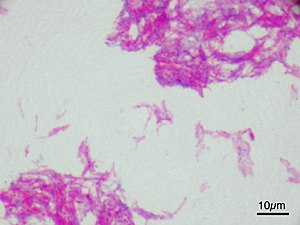BCG - the current vaccine for tuberculosis
Bacille Calmette Guerin (BCG) is the current vaccine for tuberculosis. It was first used in 1921. BCG is the only vaccine available today for protection against tuberculosis.It is most effective in protecting children from the disease.
History of the vaccine
Bacille Calmette Guerin (BCG) containes a live attenuated (weakened) strain of Mycobacterium bovis. It was originally isolated from a cow with tuberculosis by Calmette and Guren who worked in Paris at the Institute Pasteur. This strain was carefully subcultured every three weeks for many years. After about thirteen years the strain was seen to be less virulent for animals such as cows and guinea pigs. During these thirteen years many undefined genetic changes occurred to change the original stain of M. bovis. This altered organism was called BCG. In addition to the loss of virulence, other changes to BCG were noted. These included a pronounced change in the appearance of colonies grown in the laboratory. Colonies of M. bovis have a rough granular appearance whereas colonies of BCG are moist and smooth.
Today there are several strains of “BCG”.
BCG was first used as a vaccine to protect humans against tuberculosis in 1921.At first, cultures of BCG were maintained in Paris. Later, it was subcultured and distributed to several laboratories throughout the world where the vaccine strain called BCG continued to be maintained by continuous subculture. After many years it became clear that the various strains maintained ain different laboratories were no longer identical to each other. Indeed, it was likely that all the various strains maintained by continuous subculture continued to undergo undefined genetic changes. Indeed, the "original" strain of BCG maintained at in Paris had continued to change during the subcultures needed to maintain the viability of the culture. To limit these continuing changes the procedures needed to maintain the strain were modified. Today, the organism is maintained in several laboratories using a "seed lot" production technique to limit further genetic variation using freeze-dried (also called lyphilized) cells so that each batch starts with the same cells.
Safety
After extensive tests in animals, BCG was first used as a vaccine in 1921. It was given orally to infants. Since this time the vaccine has been widely used. Today, it is estimated that more than 1 billion people have received BCG.
BCG is widely used and the safety of this vaccine has not been a serious issue until recently. There is a concern that use of the vaccine in persons who are immune compromised may result is an infection caused by the BCG itself. Also, even among immune competent persons, local reactions, including ulceration at the site of vaccination may result in shedding of live organisms which could infect others who may be immune compromised.
The early use of BCG was marked by a tragic accident. In Lubeck more than 25% of the approximately 250 infants who received a batch of the vaccine developed tuberculosis. It was later recognized that this batch was accidentally contaminated with a virulent strain of M. tuberculosis.
BCG production and substrains
The BCG vaccines that are currently in use are produced at several (seven?) sites throughout the world. These vaccines are not identical. To what extent they differ in efficacy and safety in humans is not clear at present. Some differences in molecular and genetic characteristics are known. What is not known is if the "BCG" from one manufacturer is "better" than one produced at another site. Each BCG is now know by the location where it is produced. For example, we have BCG (Paris), BCG (Copenhagen), BCG (Tice) and BCG (Montreal) among others.


